
The Frankfurt airport in Germany has Nespresso Coffee kiosks. They brew coffee.
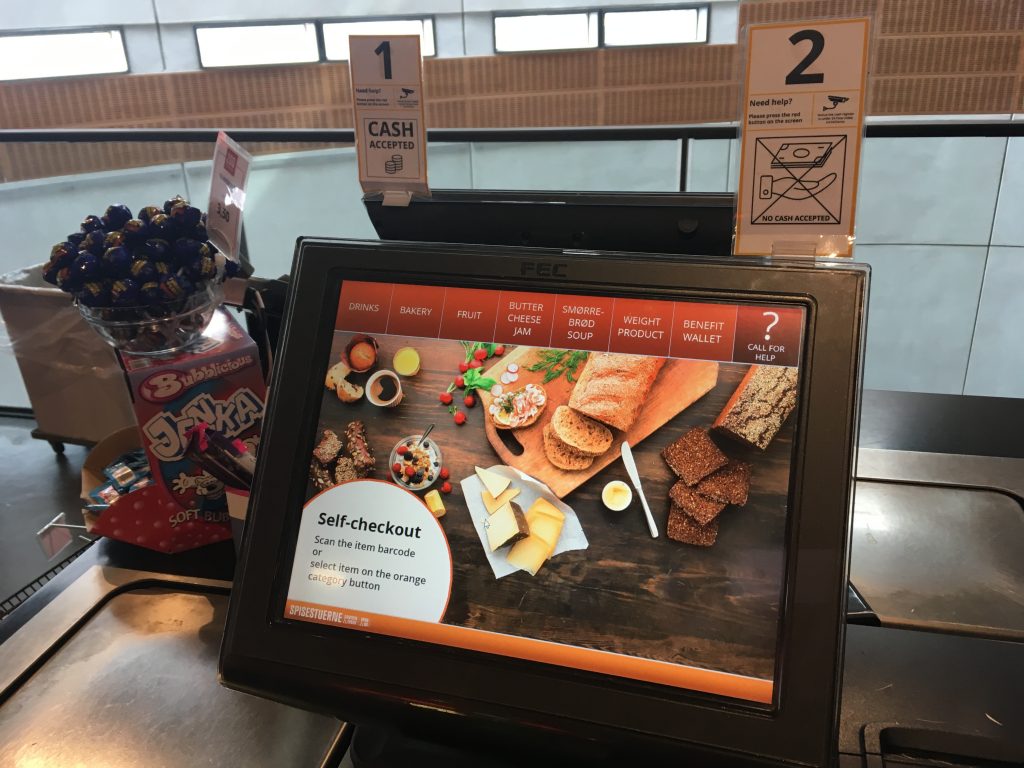
The canteen at Copenhagen Business School in Denmark has a self-checkout system. It tells how much I should pay.
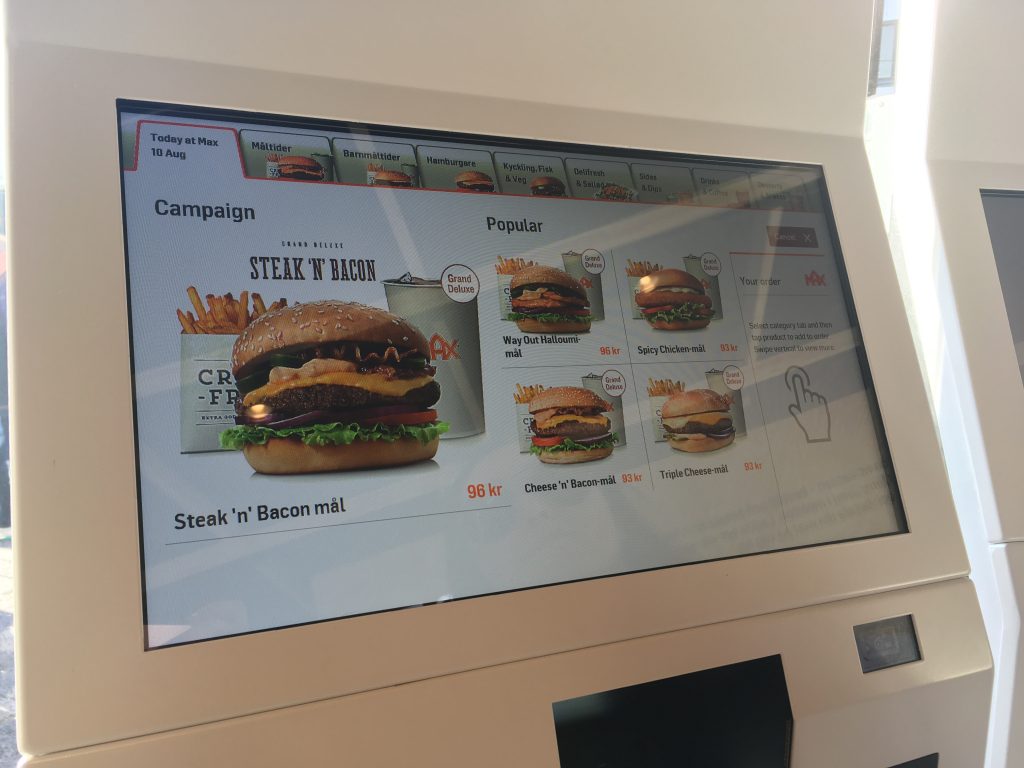
The Max, a fast food restaurant in Stockholm, Sweden, has a do-it-yourself kiosk stand. It receives orders.
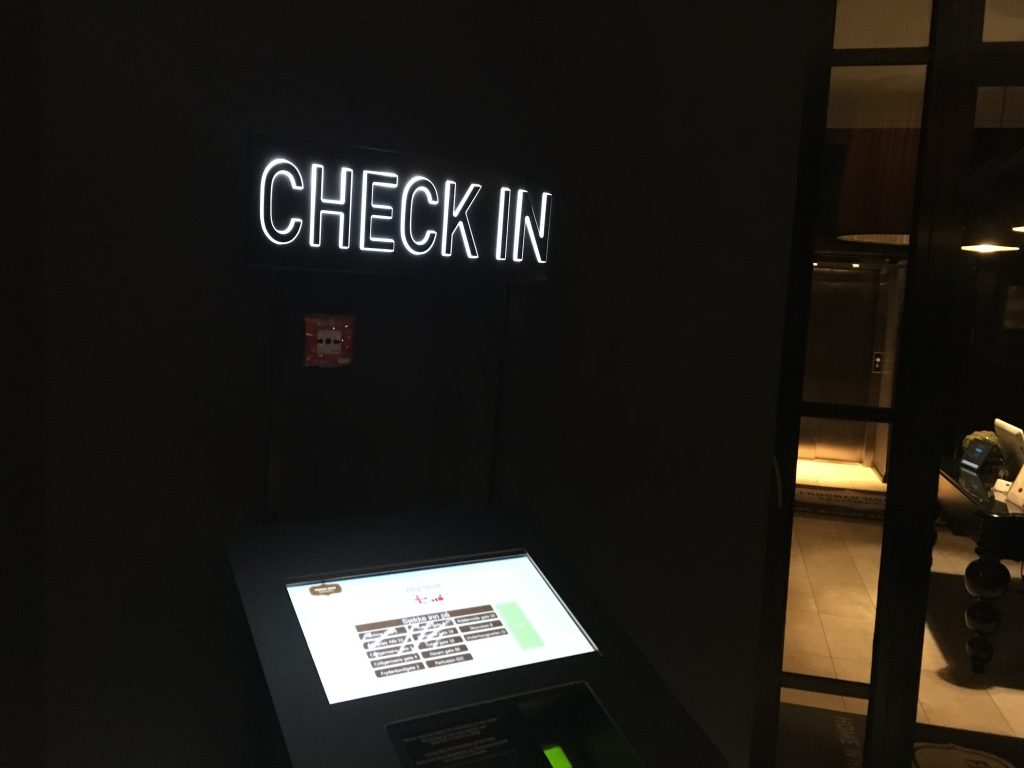
A hotel in Oslo, Norway, has a self service kiosk reception. Doors open only when reservation information is entered.
Indeed, self service kiosks are everywhere in Europe. They benefit managers and customers. Managers lower labor cost and customers avoid unnecessary relationships companies hoped for.
However, self service kiosks have two weaknesses. Gretchen Gavett elaborated them in his article titled How Self-Service Kiosks Are Changing Customer Behavior.
… Technology lacks flexibility. When we’re interacting with a person and we’re having trouble understanding something, the person can adjust to us. If we’re having a misunderstanding, they can help clarify it. Technology really can’t do either of these things.
… A person has the ability to delight us or disappoint us. It’s really hard for a technology to ever delight, however, because it’s standardized and is built on a set of rules. But it is possible for technologies to disappoint us.
I have met a good example about how to overcome the above mentioned two weaknesses. This is Neal’s Yard Dairy, a cheese store at the Borough market in London, UK. In this store, customers should talk to the person over the counter to buy cheese. While having conversation with another human being over the counter, they learn what to buy and are relieved or excited. Only people can educate AND delight us at the same time. Kiosks cannot.

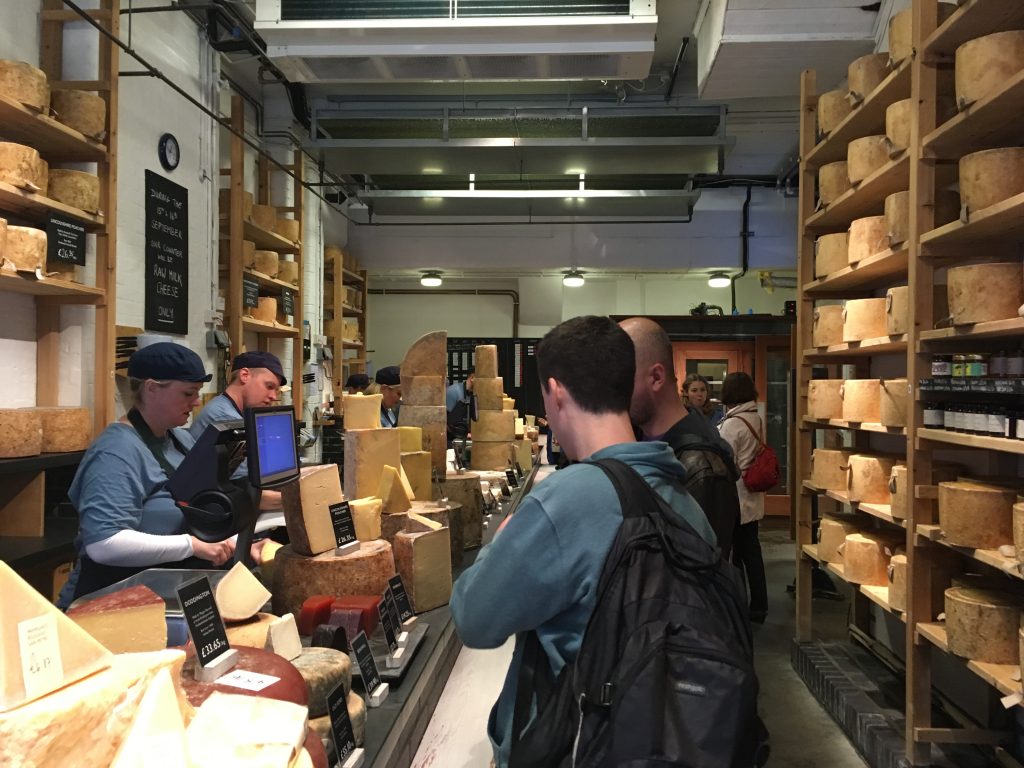
***
Reference
Gavett, G. (2015). How self-service kiosks are changing customer behavior. Harvard Business Review, 3(1), 1-6.
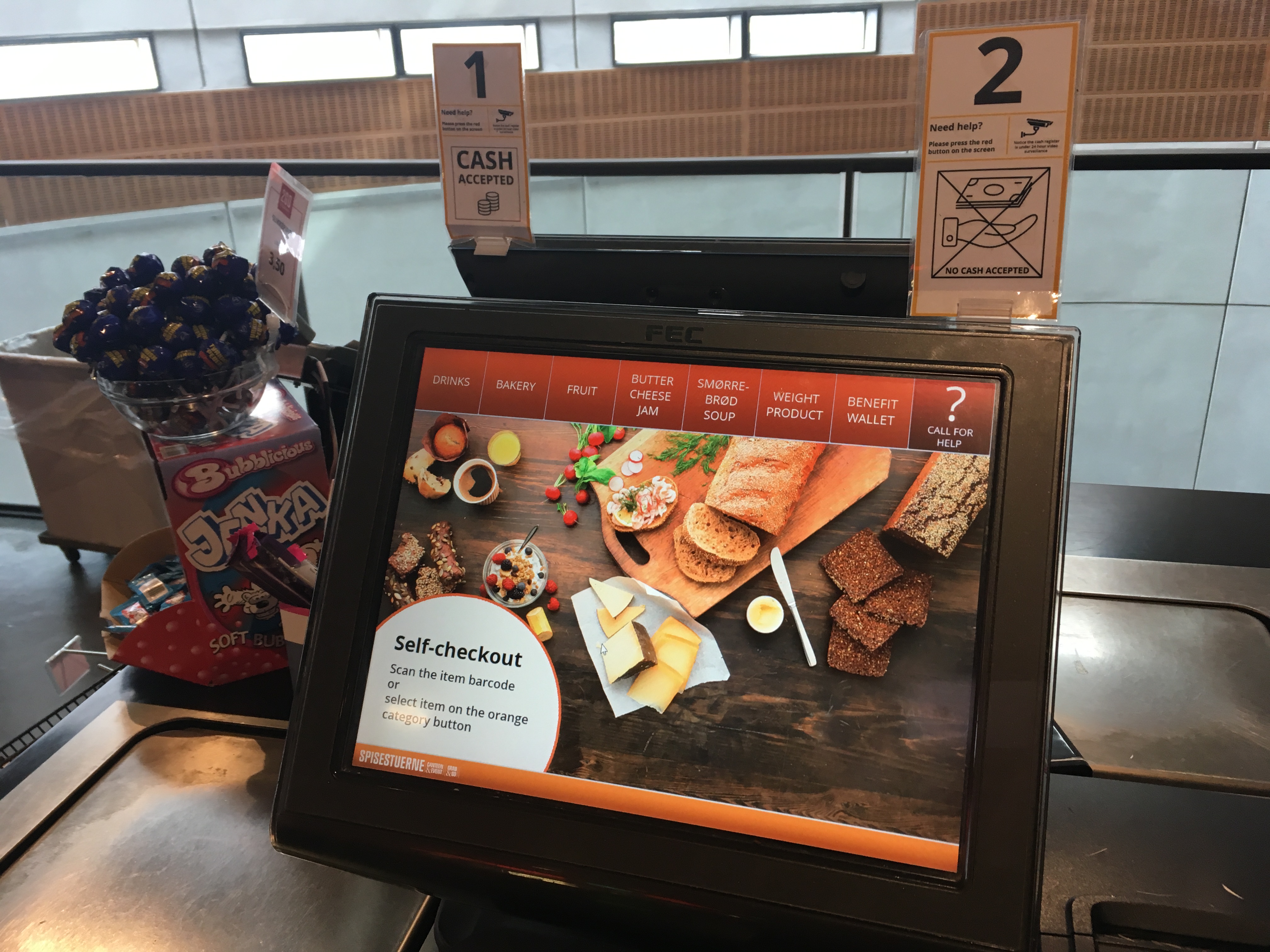
Just like the title of the post, these days, self-service kiosk machines are truly everywhere—convenience stores, supermarkets, restaurants, and more. The reason for the widespread of kiosks in many stores is that it is a win-win situation for both business owners and consumers in terms of the convenience of ordering. According to the article titled “How Self-Service Kiosks Are Changing Customer Behavior (hbr.org)” mentioned in this post, the introduction of kiosks or app ordering has been effective in increasing consumer order amounts and boosting companies’ market share by reducing service times. However, there are also drawbacks. Automation sometimes conceals the efforts made for consumers (such as service efforts). Automation technology seems fast and smooth, but consumers cannot see the effort on the back. When they cannot see the effort, the appreciation for the service decreases, resulting in less value for the service. Additionally, technology lacks flexibility, so when there is a misunderstanding in customer interactions, it cannot be resolved according to their position. As a result, it is challenging for technology to please consumers, and it frequently disappoints them.
“Could electronic agents improve customer experience in a cafe? (http://designmarketinglab.com/archives/4735)” In this post, the author proposes self-service as an alternative to automation, where customers must do everything themselves. However, I questioned whether the alternative to automation could be self-service, or would it be effective in Korea?
When we go to a restaurant, we are guided by the server to sit at a table, receive the menu, place an order, eat food, pay at the counter, and leave the restaurant. Typically, we assume that customers will be satisfied with less activity in the store. However, “Could electronic agents improve customer experience in a cafe?” post states that customers may be satisfied with doing everything on their own, contrary to common assumptions. An example is a Rainmaking Cafe in Copenhagen, Denmark. This unmanned cafe is designed to allow customers to complete the entire process from entering to leaving, but the experience is quite enjoyable and most people follow the rules. However, Danish and Korean society are a little different. I don’t think full-scale self-service will work as an alternative to automation in Korea.
In Denmark, customers may try to do their own in-store activities, but these unmanned cafes are not popular in Korea. This is because Korean consumers 1) want to receive the appropriate treatment and service for paying money, and 2) want them to feel special. This tendency of consumers is also revealed in the fact that Starbucks ranks first in sales and brand reputation in the Korean cafe market every year. Starbucks does not provide kiosks or vibration bells, but employees take orders themselves, and call out customers’ nicknames at the pickup zone. This strategy makes consumers feel treated and differentiated. According to the Prospect Theory of Behavioral Economics, consumers who have a good experience cannot return to the existing experience. Basically, it is because people feel losses more than gains. (It is also called ‘Losses loom is larger than gains’) Therefore, consumers who have experienced the differentiated services provided by Starbucks will not want to return to self-service stores where they do not receive any services. In addition, once a preference is formed for something like this, consumers will not try to change their attitudes because they try to maintain consistency.
In addition, Korean consumers 3) do not think product and service costs separately. They think that service costs are included in the products they buy. So, there is no paid toilet culture in Korea, as “Pay toilet, spoiled customer, and mental accounting (http://designmarketinglab.com/archives/2620)” states. This is because they think that purchasing a train ticket includes the service fee for the facilities inside the train station. The same goes for coffee. The reason why many people visit Starbucks is because of its “taste,” but also because they can pay for a cup of coffee, receive friendly service from the staff, and use a nice atmospheric space. Starbucks drinks in Korea are the fifth most expensive in the world (based on a tall sized latte). The Americano at Starbucks is about three times more expensive than the Americano at an unmanned cafe. But consumers are more inclined toward Starbucks, because they are willing to pay any amount for the experience they want if someone provides it.
In the current era, kiosks can be found almost anywhere, be it in restaurants, cafes, banks, or even parking lots. With the advancement of IT technology, kiosks have become ubiquitous in people’s daily lives. Despite the increasing deployment of kiosks, there are ongoing issues, particularly concerning the diverse user experiences.
For instance, cafes implementing kiosks have seen benefits such as faster order processing and reduced rotation and labor costs, as cashiers no longer need to take orders, focusing solely on preparing beverages. However, in famous franchise burger joints like McDonald’s and Lotteria, catering to a broad age range, issues have arisen as kiosks seem to overlook considerations for elderly users. Elderly individuals who struggle with handling IT devices often find themselves unable to place orders through kiosks and may have to rely on younger patrons for assistance, contributing to a sense of isolation among the elderly.
Efforts are being made to address these issues, including the development of various kiosk UX/UI designs and guides for the elderly. Educational programs on smartphone and kiosk usage targeting the elderly are also being conducted in places like senior welfare centers. Nevertheless, catching up with the widespread deployment of kiosks, as seen in various locations, remains a challenging reality. It is not easy to find places without kiosks, and establishments like the cheese shop mentioned in this post, where orders are taken directly by people, are becoming rarer.
Starbucks, a globally recognized coffee company operating thousands of stores worldwide, stands out as a famous franchise that has not adopted kiosks. Despite being a tech-savvy company known for actively analyzing and integrating data into its business operations, Starbucks has opted not to install kiosks. Starbucks’ success in utilizing IT technology, known as the “data business” textbook, raises questions about how they have effectively employed these technologies.
Starbucks initially prioritized analog sensibilities but began leveraging data to address a decline in revenue caused by increased competition in the coffee industry and the global financial crisis in 2008. Utilizing its internally developed application, Atlas, Starbucks analyzes data to determine optimal store locations, staffing needs during major events, and the quantity of coffee required. Starbucks also ensures a consistent coffee taste worldwide by using the Clover Brewing System, which digitally controls factors like water temperature, quantity, and roasting viscosity during the coffee extraction process.
All of Starbucks’ technological advancements serve one overarching goal – creating the “third place.” Starbucks aims to provide a space for meetings, comfortable studying, and an overall third-place experience. Unlike other franchises that have adopted kiosks, Starbucks differentiates itself by placing customer-centric thinking at the forefront. While Starbucks employs technology, such as the “Siren Order” feature in its mobile app, allowing customers to order and pick up at the selected store, traditional kiosks are noticeably absent.
Starbucks values customer experience and ensures that any potential inconveniences are not exposed. Direct communication with Starbucks partners, the ability to place orders through the Siren Order feature, and a focus on providing a comfortable environment set Starbucks apart. While some stores benefit financially from kiosk usage, it may not be the right strategy for all establishments. Those considering kiosk installation should carefully analyze their store’s characteristics, customer base, and the overall user experience before making a decision.